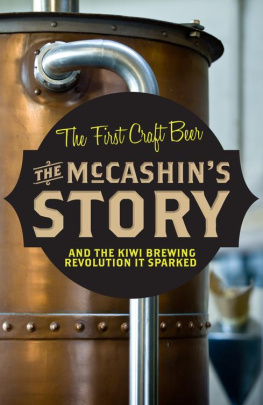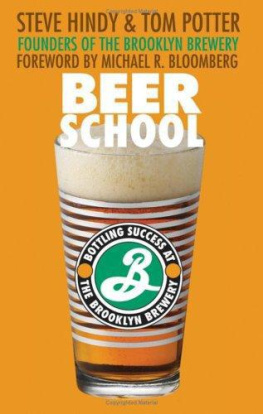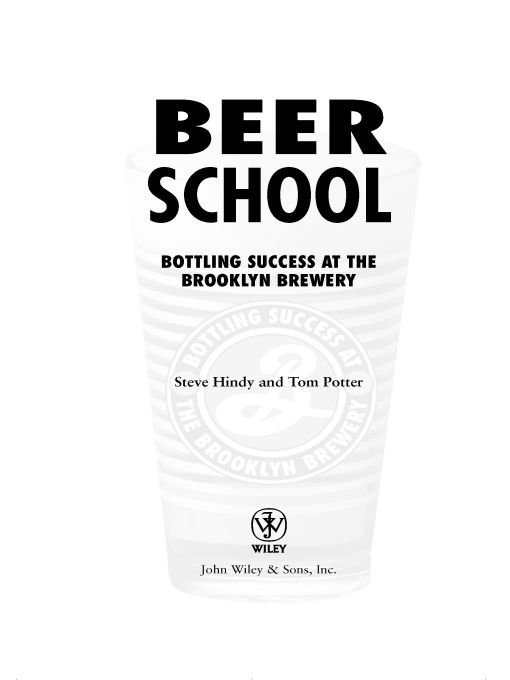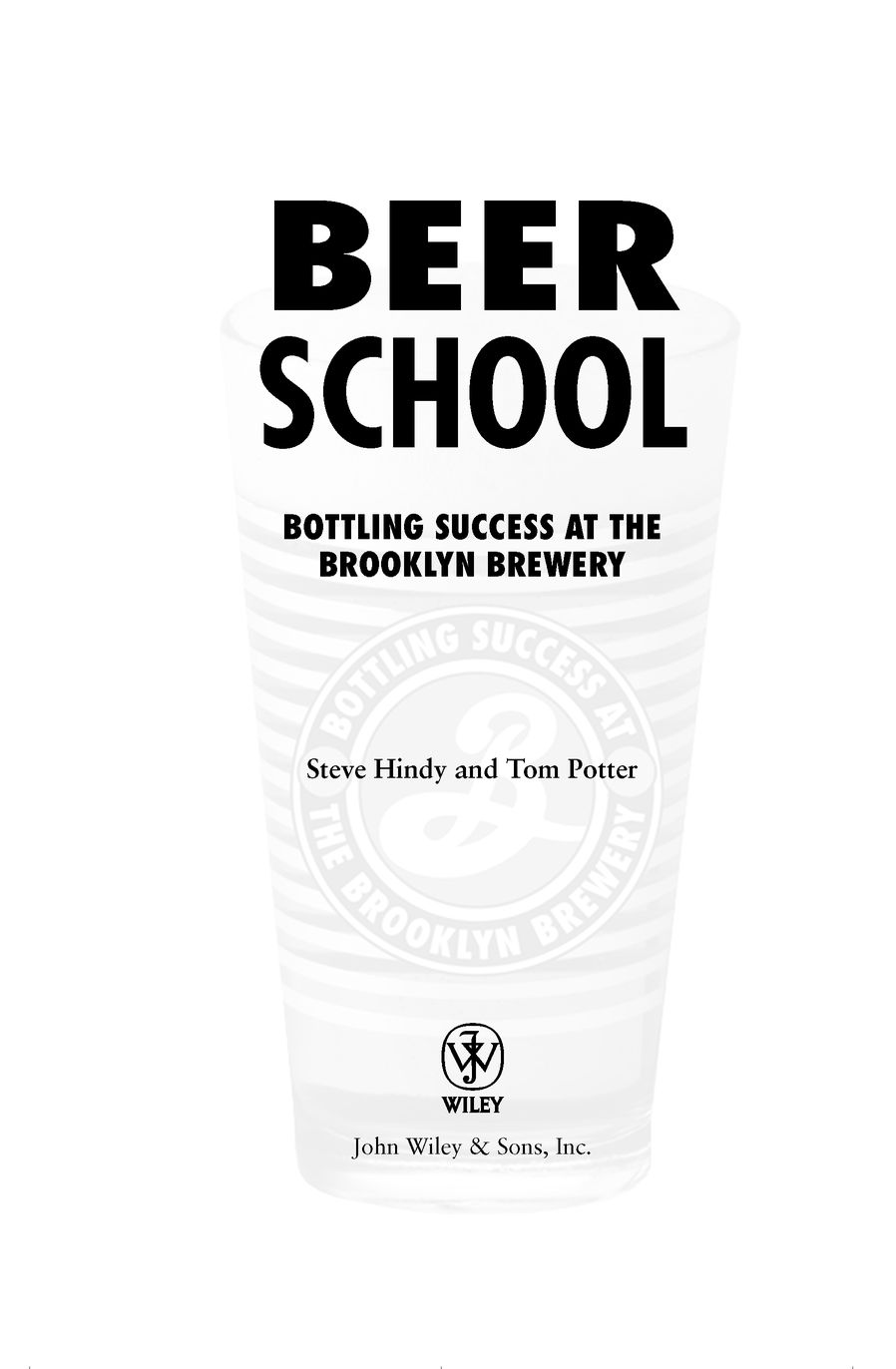Table of Contents
This book is dedicated to our wives, Gail and Ellen, and to our children, Bill, Sam, and Lily. Without your love and support there would have been no book to write and no business to write about.
Foreword
A warning: Three things are bound to happen as you read this book. First, periodically, you will become thirsty. Prepare your refrigerator. Second, you will want to visit the Brooklyn Brewery for a tour. Prepare your itinerary. And finally, if you have ever considered starting your own business, you will be inspiredand scared. Prepare yourself.
As someone who began a start-up company in 1981 with three men and a coffeepot, Steve Hindys and Tom Potters story rings true as an honest accounting of the sheer determinationand good luckrequired to nurture a business from conception to maturityand the inevitable mistakes that are made along the way. But their success story is about more than the birth of a brewery; its about the rebirth of a borough. In so many ways, the Brooklyn Brewery symbolizesand helped to createthe renaissance that has taken hold in Brooklyn.
When Steve and Tom leased an old ironworks building in Williamsburg in 1994, the once thriving industrial district had long lost its vitality. For decades, manufacturing jobs had been moving out of Williamsburg and overseas, leaving behind abandoned warehouses and crumbling buildings. To many, Brooklyn seemed to be dying. But Tom and Steve believed in Brooklyns historyits rich tradition of brewing and its wealth of cultural icons and institutions: Walt Whitman, Jackie Robinson, and all the Dodger greats, Coney Island and the Cyclone, the Brooklyn Bridgeto name a few. They understood that Brooklyn is more than an address; its a spirit, an attitude, an identity. And they betcorrectlythat hometown pride would lead New Yorkers to embrace Brooklyn beer as their own.
In the more than 10 years since the brewery opened, Brooklyn beer has become a popular and successful brand, and Williamsburg has grown into one of New York Citys hottest residential neighborhoods. Steve and Tom helped make Williamsburg hipsponsoring block parties and music festivals and opening the brewery to tours and Friday night happy hours. But as the area changed from a decaying industrial center to a vibrant residential neighborhood, its antiquated zoning regulations prevented the development of new housing and sealed off the waterfront from residents.
As the city began the process of rezoning the area, community input was solicited. Steve and Tom helped residents participate in the discussion by hosting a public meeting at the brewery attended by city officials. In May 2005, with strong support from the community, the city completed the largest waterfront rezoning in its history, which will result in new housing along a waterfront esplanade. In addition, the plan creates a special industrial park to ensure that manufacturing companieslike the Brooklyn Brewerycan continue to succeed and grow in the area.
More than opening their doors to community events, Steve and Tom have taken an active role in Brooklyns civic life, sponsoring fund-raisers for Prospect Park and exhibits at the Brooklyn Historical Society. New Yorkers, especially myself, are particularly grateful for their support of the Jackie Robinson and Pee Wee Reese monument commissioned for KeySpan Park, home of the Brooklyn Cyclones. Steve and Tom are helping to bring the monument to life by generously donating $1 from every case and $5 from every keg that they sell of Brooklyn Pennant Ale 55.
Beer School is the story of the incredible challengesmost of them unanticipatedthat entrepreneurs experience and the hard road that is traveled from planning to profit. But Steve and Tom have done more than build a profitable business; they have played an integral part in revitalizing Williamsburg and fostering Brooklyns renaissance. In doing so, their public-spirited brewery has become part of Brooklyns identity. I tip my hat, and lift my glass, to them both.
Michael R. Bloomberg
New York City
June 2005
Preface
STEVE AND TOM INTRODUCE THE BROOKLYN BREWERY
The Brooklyn Brewery is among the top 40 breweries in the United States, selling nearly 45,000 barrels of beer in 2004. With 17 years in business, the company has risen above many multinational giants to become the number six draft beer in New York City and a virtual institution in Brooklyn, a borough of more than 2 million inhabitants. How did we, Steve Hindy (a journalist) and Tom Potter (a banker), with no experience in the beer business, turn a hobby into a multi-million-dollar business and develop both a beer brand and a distribution company in the most competitive beer market in the United States?
It wasnt easy. We started, textbook style, with a wellresearched business plan and $500,000 raised from family, friends, and an ever widening network of people who invested in the Brooklyn Brewery. We soon learned that starting a business was an all-consuming enterprise that tested us, our relationship as partners, and our relationships with our families and our community. As partners, we were essentially married. Our only child was the Brooklyn Brewery, and we faced many challenges in raising that child, the same way parents wrangle over how to raise their offspring. More often than not, we agreed on how to proceed, and we were thankful for such a strong partnership that could withstand the burdens and anxieties of building a company. When we didnt agree, the very foundation of the company was threatened. Employees took sides. It got nasty.
We learned that when we could not find a conventional way to get something done, we had to make our own way of doing things. Sometimes we succeeded, and sometimes we failed miserably. We learned the value of maintaining a focus on the main purpose of the company.
We learned that we were attempting to become part of an industry that was dominated by large multinational corporations with tremendous resources at their disposalcompanies that greatly value a presence in New York City because it is the center of the worlds financial institutions.
We learned that start-up companies have some important advantages over large companies. The media and many other businesses are always rooting for David over Goliath. Exploiting these advantages is essential to success.
We learned that our investors initial concerns about the Mafia in New York were not unwarranted, and that no company is too small to find itself a target of such threats. We learned that protecting your business and its employees sometimes means that you might have to look down the barrel of a gun. It is your business, and there is no one else to turn to.
We learned that entrepreneurs have to articulate a dream, inspire their followers to believe in that dream, and work tirelessly for its realization. But we also learned that entrepreneurs have to let go of control of the dream and allow their followers to take ownership.
We learned that the conventional wisdom of getting in on the ground floor of a successful business does not always mean that you are going to enjoy the fruits of that business. We learned that banks and venture capitalists are not always the preferred way for an entrepreneur to finance an enterprise.
We learned that selling a successful business is a perilous undertaking, even when there are competing buyers.









